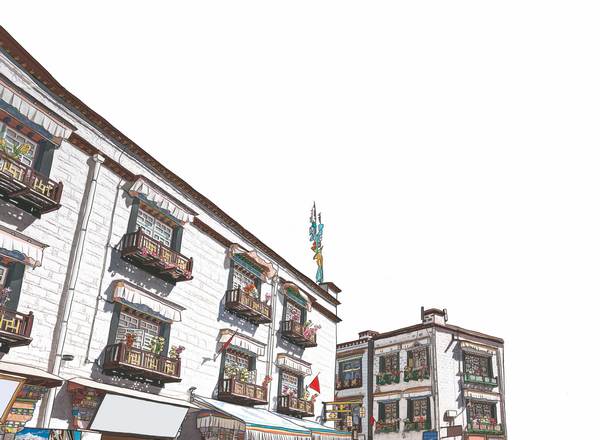

Step off Barkhor Bazaar and into the narrow surrounding alleyways and you soon feel as if you are entering another world, away from the hustle and bustle beyond.
Silence is restored upon entering one of the old courtyards and closing its doors, where you are let into the home of Penba, a female group leader of the courtyard, designated by the community, and her secret back garden.
Having lived here since she was a child, the 61-year-old sometimes begins her day by getting up at 6 am to sweep the courtyard and clean the shared toilet on the second floor of the two-story structure. As she goes about her routine, she records it on her mobile phone and later uploads the short video to a group chat on WeChat.
The members are all courtyard residents from some 18 households, who take it in turns to do the morning cleaning, and prove they've done their job via short videos.
She says it is necessary for everyone to obey the rules and ensure the public environment is welcoming to all.
Penba lives with her husband, daughter and two school-age grandchildren in the house on the first floor where she grew up. The family of five shares a home about 36 square meters in size.
She tries to keep the inside and outside of her home clean and cozy.
"I hope every member of the courtyard also feels the same," she says.
This is why she always encourages her neighbors to clean thoroughly and on time, and why every household grows potted flowers to make the old courtyard lively.
The courtyard is home to 45 inhabitants including her family, according to the notice on the wall at the entrance of the courtyard that displays details of the courtyard.
Next to the notice is an emergency box containing medicines for different ailments.
The courtyard has undergone several transformations. Penba says the earliest she can remember took place between 1995 and 1996.
"The structure was reinforced while the original Tibetan style was retained. The ground was repaved so that when it rains, there isn't dirt everywhere and rooms aren't flooded." Water pipes have also been installed and now residents enjoy the convenience of fetching water from a pump in the courtyard.
According to Xu Meng, an urban planner at the China Academy of Urban Planning and Design, since the peaceful liberation of Xizang in 1951 the historical architecture of Barkhor Bazaar and its neighboring alleys and courtyards, known as the Old City of Barkhor, have been renovated, making daily life for people living in the area more comfortable in the process.
"The renovations have been carried on in several stages," he says. "First the protection of certain historical buildings, then the conservation of the layout of the streets and the Old City, and in recent years the improvements to the infrastructure."